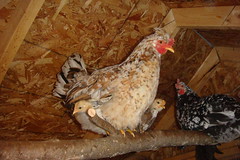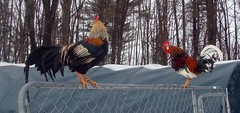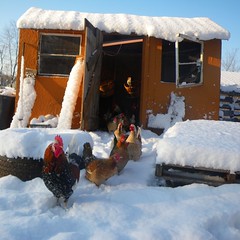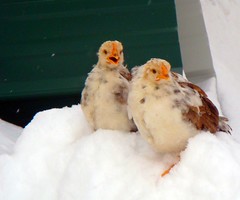Icelandic Chickens are just chickens, I know. So a lot of how we care for them is just good chicken care practice. But they also have some unique characteristics.
 One of the things we discovered when we first got the birds is that they are very particular about where they want to lay their eggs. When we built their coop, we tried all sorts of nesting box designs. Milk crates, boxes, half doors, placed on the back wall in the dark corners of the coop. They hated them. What these hens want are apple baskets set waist high, filled with hay. Luckily, I can get them at my local feed store for about $7 each, and they last a really long time because they are up off the ground. We just screw them to the wall and keep them filled with fresh hay.
One of the things we discovered when we first got the birds is that they are very particular about where they want to lay their eggs. When we built their coop, we tried all sorts of nesting box designs. Milk crates, boxes, half doors, placed on the back wall in the dark corners of the coop. They hated them. What these hens want are apple baskets set waist high, filled with hay. Luckily, I can get them at my local feed store for about $7 each, and they last a really long time because they are up off the ground. We just screw them to the wall and keep them filled with fresh hay.
 These chickens fly. They fly really well. It is not uncommon to see them on the roof of the coop or the top of fences. It’s almost impossible to keep them out of places we don’t want them, though we’ve had pretty good luck teaching them to stay out of the veg garden by squirting them with a hose when we find them there. They are also pretty small, so fit through things like cattle panels. Thus, we pretty much let them go wherever they want, because trying to keep them somewhere is almost impossible.
These chickens fly. They fly really well. It is not uncommon to see them on the roof of the coop or the top of fences. It’s almost impossible to keep them out of places we don’t want them, though we’ve had pretty good luck teaching them to stay out of the veg garden by squirting them with a hose when we find them there. They are also pretty small, so fit through things like cattle panels. Thus, we pretty much let them go wherever they want, because trying to keep them somewhere is almost impossible.
 They like to roost as high up as they can. We’ve placed roosts up underneath the roof ridge beams, and even when the babies aren’t even a month old yet and still getting under mama for warmth, they are up on those roosts. We try to keep as much space for them up there as we can get, because they’ll all try to fit on the highest ones, and roosts even just six inches lower are ignored and they’ll all crowd together and fuss for the best spots on the highest ones.
They like to roost as high up as they can. We’ve placed roosts up underneath the roof ridge beams, and even when the babies aren’t even a month old yet and still getting under mama for warmth, they are up on those roosts. We try to keep as much space for them up there as we can get, because they’ll all try to fit on the highest ones, and roosts even just six inches lower are ignored and they’ll all crowd together and fuss for the best spots on the highest ones.
 We’ve had really good luck with having good roosters. We tend to keep ones that can establish their own harems and take their girls into the coops at night. Ones that don’t dance for the ladies and treat them right are dispatched to freezer camp as quickly as we can do it. We keep about a 10-1 ratio of boys to girls, and find that works out pretty well. We had some who were roosting in trees and refused to move to the coop, but we won’t keep those, because it’s just not safe enough here in the land of fisher cats and really cold weather.
We’ve had really good luck with having good roosters. We tend to keep ones that can establish their own harems and take their girls into the coops at night. Ones that don’t dance for the ladies and treat them right are dispatched to freezer camp as quickly as we can do it. We keep about a 10-1 ratio of boys to girls, and find that works out pretty well. We had some who were roosting in trees and refused to move to the coop, but we won’t keep those, because it’s just not safe enough here in the land of fisher cats and really cold weather.
 Speaking of cold weather, these chickens just don’t care what the weather is like. They’d much prefer to be out in it than kept inside the chicken coop. (I mean, who wouldn’t?) But neither rain nor snow nor sleet will convince them that inside is better than outside. We tend to keep them some paths shoveled in the snow to many of their favorite places, but even if we don’t, the roosters just forge new trails and out they all go.
Speaking of cold weather, these chickens just don’t care what the weather is like. They’d much prefer to be out in it than kept inside the chicken coop. (I mean, who wouldn’t?) But neither rain nor snow nor sleet will convince them that inside is better than outside. We tend to keep them some paths shoveled in the snow to many of their favorite places, but even if we don’t, the roosters just forge new trails and out they all go.
 We have found the hens to be quite reliably broody. There doesn’t seem to be a particular time of year for it, even. We’ve had broodies pop up in all seasons. They are quite good at setting until the babes hatch, and I’ve found that placing a round plastic laundry basket on top of the apple basket we use for nest boxes to be a good way to keep the rest of the hens from continuing to lay eggs under the broody so that we get a decent hatch, all at the same time.
We have found the hens to be quite reliably broody. There doesn’t seem to be a particular time of year for it, even. We’ve had broodies pop up in all seasons. They are quite good at setting until the babes hatch, and I’ve found that placing a round plastic laundry basket on top of the apple basket we use for nest boxes to be a good way to keep the rest of the hens from continuing to lay eggs under the broody so that we get a decent hatch, all at the same time.
 One of the things that amazed me is that it really doesn’t matter what the weather is like when the babies hatch. With all the trouble we go to when we hatch some in the incubator and need to brood them under a heat lamp, when the hens hatch some and there is snow outside? Too bad, babies. Out we go! We’ve seen the mamas take them out in freezing rain, heavy wind, snow storms, whatever. These mighty Viking chickens aren’t bothered by weather, no matter what the conditions are.
One of the things that amazed me is that it really doesn’t matter what the weather is like when the babies hatch. With all the trouble we go to when we hatch some in the incubator and need to brood them under a heat lamp, when the hens hatch some and there is snow outside? Too bad, babies. Out we go! We’ve seen the mamas take them out in freezing rain, heavy wind, snow storms, whatever. These mighty Viking chickens aren’t bothered by weather, no matter what the conditions are.
We leave out grain, all you can eat, and we use an Agway product called Egg Producer. It’s 21% protein, and we have very good luck with it. Regular layer feed is 16% for the same price. When there are bugs and grass, however, they basically ignore it, so for at least five months of the year, they don’t cost us anything to feed. In tropical places like Keene, they will find even more free food, for longer.
In the winter, we have a light on in the coop from September to April from 4:30 a.m. until 6:00 p.m. These birds are used to low light winters being from Iceland and all, but we find them quite reliable layers with that amount of light. We also keep the water heater going so they have liquid water available. We don’t otherwise heat the coop.
Please note. This is a 2010 blog post. The husbandry information remains good. For current purchasing information, please go check the webstore. (Click ‘shop’ on the banner, as of 2014.)
If you would like some Icelandic Chickens of your very own, we are selling hatching eggs for $1 each and day old chicks for $4 each. We take a $25 deposit for the hatching eggs, then run a batch through the incubator and you take all that hatch. Drop us a line if you would like some!
Great information! Could you tell me what sizes the baskets are, I have ducks and the ones who don’t just drop them on the hay who look for and build a nest would do better if they had a basket. Do you ever ship chickens?
elayne in Idaho
Hi Elayne,
We use standard bushel baskets. I can’t imagine a farm store that doesn’t have them.
We do indeed ship chicks. Our 24 egg incubator holds 30 Icelandic eggs (USDA medium). We mail you whatever hatches at $4 per chick plus $12.50 shipping. We use real baby chick shipping boxes. We haven’t had great luck shipping eggs. Next time we’ll try buying a special egg shipping box. I’ll have to quote that when we get an order.
Frank
The Icelandic chickens look very similar to my Mille Fleur bantams and the description fits them to a tee! Broody whenever, nests well, likes being up high, out in the winter (we too snowblow paths for them) and great layers, etc. Supposedly they are one of the most cold climate chickens. But, I don’t know much about chickens except the ones that we have – 8 new chicks this past month. Thanks for sharing the apple basket idea. We need to add new nests and that’s a great idea.
Martha Verville
Hi Lisa, will you ship eggs for hatching as well?
We have shipped eggs before, but we haven’t had much luck with it. The first time we did it, he got a great hatch rate, but everyone I’ve since shipped too has only had a few hatch out of two dozen.
Frank says there are special egg shipping boxes that we might try.
We got some eggs from Wisconsin heqtapped the eggs in old fleece from the sheep we had a pretty good hatch. I even just put the eggs under a broody Orpington instead of an incubator
do you still sell icelandic chicks still?
and have any new bloodlines been imported lately-or are yours from the first imported eggs-thanks Gentian
What is the temperament of this breed? Are the roos ever fiesty?
What is the minimum order for chicks? Thanks!
They’re friendly enough and come running for worms when Lisa weeds, but don’t flock to us like the Chanteclers do. They also seem smarter than the chanteclers. Like all Icelandic animals they expect open (not just free) range. A fence is something to fly over.
We’ve never had trouble with a roo, and Egil is now 4. Cockerels get rowdy of course. We put them in a bachelor pad until they reach eating size.
The order size is whatever comes out of the incubator. We have one ‘bator, which holds 30 Icelandic eggs. We ship you whatever hatches (usually over 20) for $4 each plus $15 shipping.
I have just mailed all your info to our DD’s farm. She Loves Her chickens. Yes, truly. They are all raised organically and free range. Lovingly. Don’t send her any rooster LOL or she will have them forever. 🙂 Beautiful site you have here.
I am considering some Icelandics, and have a couple questions, does this breed get along with other chicken breeds if kept together ? You say they prefer open range, exactly how far do they fly, and do they return too roost in the evening like other breeds ? I live fairly close too you, is it possible for us to setup a time to visit your farm and see the Icelandic chickens ?
The do get along with other chickens. The roosters get along “really well”. They’re they’re the bad boys with motorcycles that girls love. We’ve never had a problem finding enough nice ones though. The mean ones are yummy.
They do fly and wander. The six foot fence around the garden merely makes them think before they put in the effort to fly over it. They will go several hundred yards. They will normally come back to the coop at night, but if the coop gets crowded they will try to split into subflocks, with a rooster and a few hens picking out a tree or shed to start sleeping in.
Yes, you can certainly come over and meet them. Mud time is slowly ending and the farm looks much better than it did a few weeks ago.
Frank thank for the info .. we look forward too visiting you.
Yummy is good !!
We have lot of big trees …
Mud season is not a problem 🙂
We’ll give you a phone call before we head on over.
Hi Lisa, Frank, I have about a year of experience with Wyandottes and Easter Egger chickens that are locally available (New Mexico), as well as a pair of Welsh Harlequin ducks. I’ve read ducks are much more disease-resistant than chickens, and so far in my limited experience that certainly seems to be true. I’m curious if you have any opinion on the relative hardiness of Icelandies compared to the overbred standard varieties of chickens generally available? I’m starting to think I should just clear the chicken decks and import my Icelandics next spring!
Thanks,
Sue
We’ve only had two breeds of chickens — Icelandics and Chanteclers. We have found the Icies incredibly hardy. They handle 30 below 0 in an unheated coop, up in the rafters of our chicken coop, which isn’t insulated or anything. We’ve had no problems with diseases or anything like that with them since we started, in 2005.
I’m a bit smitten with the breed, though, so grain of salt and all that!
Any idea how they would do in Louisiana? They’ll see snow only every three or four years and summers are hotter than they would be accustomed to. If they can fly that well they’re evidently a light breed and perhaps can do ok?
Thanks,
Tommy
There are several people in Texas who have them and say they do fine as long as they have access to plenty of shade and water.
Hi, folks. How do your Icelandic chickens compare to your Chanteclers? I have Partridge Chanteclers plus a couple other breeds I’m testing (Dominique and Wyandotte) for both eggs and meat. In winter I don’t heat or give supplemental light. For the breeds I’ve tried so far, they do make a mess of my gardens and the hose technique doesn’t reliably keep them out. This year I trimmed my birds’ flight feathers to restrict them to their summer yard and had my best garden year ever without the chickens interfering. Sound like Icelandics might be unhappy with that amount of confinement, yes?
Thanks for sharing.
I am interested in ordering 20 or so Icelandic chics from you but I can’t seem to find your contact info anywhere. The chicken fever must me affecting my vision. I would love to have a breed of chicken that doesn’t stay in the coop half the year waiting out the harsh Northern Michigan winters.
Thanks,
Kenny
Yes, I am interested in ordering chicks. I would like to order 20 or 30 chicks. Please let me know what I need to do next.
Thanks
Jane
I would love to order some of your icelandic chicks, are you still taking orders this year? What would be the price and how many to I have to order? Thanks for your time.
I have been told they hatch out their eggs in 19 days, not 21 as other hens? Is that true and is there a reason known for it, please?
My hatch mainly on day 21. I have had a couple that will arrive on day 20, but never in 19 days.
sheesh, wordpress seems to have eaten my reply to Paula. Anyway, yes they normnally hatch in 19 days. I have some circumstantial evidence that it’s temperature dependent. I’ve had a few batches take 21 days, all when the house was cooler than normal. I’d have thought my Brinsea incubator could handle it, but the correlation is there.
There is a very similar Norwegian landrace, I’d check their gestation if I was looking into this.
I was wandering if you you could ship eggs and if so how much would they be. Thanks
Hi Lisa, I follow your blog, your farm blog, and the Icelandic FB and I’m so grateful for all the time you put into them all. I can’t wait to get moved to Maine (by this summer or fall) and I’ll order 20 or so chicks from you and hopefully drive over to get them.
I know there are ME breeders but your birds have the best colors patterns and color diversity I think. Plus I know you have been breeding and culling since ’05.
The above is great information! Leecia
how good are they at laying eggs, how good to eat and about how many lbs are they .very disappionted on my bjgs chicks. looking to buy chicks in spring ..
The roos run about 4.5 lbs, the hens a bit under 4, live weight. The surplus cockerels dress out at 2.25 lbs with spooky consistency. After a summer of eating far more bugs and grass than bought feed, they are delicious. They have also gotten an awful lot of exercise, so they will be tough.
They will lay 5 medium eggs pre week in Spring and Summer, and slow down to perhaps 3 in the fall and winter. You do have to keep on top of them in the winter or the eggs will freeze.
I am considering Icelandics and have five acres, mostly for the two horses who live here. But what I would like to know is how do you protect them from the predators? I’ve lots a couple to hawks and almost lost one to a fox. My husband won’t let me have a rooster because he doesn’t want to upset the neighbors.
Thanks for your help.
We use Guardian Dogs — Great Pyrenees, dogs bred to protect livestock.
We got both of ours from National Great Pyrenees Rescue. Can’t imagine farming without them. We lost so many critters before we got them.
A friend of mine who has a Maremma says I need LOTS more room than five acres to have a LGD. I have thought about it though.
Maremmas need more space than Great Pyrs. I bet 5 acres is plenty for a Pyr or two.
Do you have any day old chicks available any time between now and spring?
What is the current (2015) price for hatching eggs? During what time do you ship? Thank you.
Our lists are closed for the year.
I have read your info and other info…Icelandic turn soil because they dig, are hearty, but are very small bodied. I am surrounded by woods and coyotes so I am hesitant to place them where they would be free to roam. We live near top of ridge in Appalachia so prior birds got lost down below even when we called and shook feed barrel; they loved their freedom more than the feed bucket. Eventually neighbors found them and the birds met their demise at the hands of the hillbillies! I have studied TONS of homesteading books but just can’t get around the coyotes. My only solution is fencing But this Norwegian family loves idea of Icelandics. Any ideas on coyote/fox/raccoon/possum proofing for such independent Icelandics?
We use Guardian Dogs to protect our critters. (Great Pyrs specifically that we got from National Great Pyr Rescue.) Can’t imagine farming without them. They’ve handled coyotes, foxes, bear, and even a rabid fisher.
I do not know whether it’s just me or if perhaps everyone else experiencing issues with your blog.
It appears as if some of the text in your
posts are running off the screen. Can someone else please provide feedback
and let me know if this is happening to them too? This could be a issue with my
web browser because I’ve had this happen before. Kudos